AltoShaam Low Temperature Cook & Hold Oven 750-TH-II User manual
- Category
- Ovens
- Type
- User manual

M N - 2 9 7 5 6 • 1 2 / 1 1
p r i nt e d i n u . s .a .
Cook & Hold Oven
Manual Control
Model:
500-TH-II
750-TH-II
1000-TH-II
•InstallatIon
•operatIon
•MaIntenance
1000-TH-II
500-TH-II
750-TH-II
W164 N9221 Water Street • P.O. Box 450 • Menomonee Falls, Wisconsin 53052-0450 USA
PHONE: 262.251.3800 • 800.558.8744
USA/CANADA
FAX: 262.251.7067 • 800.329.8744
U.S.A. ONLY
www.alto-shaam.com

Delivery ...................................... 1
Unpacking .................................... 1
Safety Procedures and Precautions ................. 2
Installation
Installation Requirements ...................... 3
Clearance Requirements ....................... 3
Dimension Drawings, weights & capacities ........4-5
Options and Accessories ....................... 6
Stacking Instructions .......................... 7
Leveling ................................... 8
Restraint Requirements - Mobile Equipment ........ 8
Drip Tray Installation .......................... 9
Electrical Specifications. . . . . . . . . . . . . . . . . . . . . . . 10
Operating Instructions
User Safety Information ....................... 11
Before Initial Use ............................ 11
Operating Instructions ........................ 12
General Holding Guidelines .................... 13
Care and Cleaning
Cleaning and Preventative Maintenance .......... 14
Protecting Stainless Steel Surfaces .............. 14
Cleaning Agents ............................ 14
Cleaning Materials .......................... 14
Equipment Care ............................ 15
Clean Daily ................................ 15
Clean the Door Vents ........................ 15
Check Overall Condition of Oven ................ 15
Sanitation
Sanitation/Food Safety ....................... 16
Internal Food Product Temperatures ............. 16
Service
Trouble Shooting ........................... 17
Exterior Service View ........................ 18
Exterior Service Parts List .................... 19
Electrical Component Service View and Parts List ... 20
Cable Heating Service Kits .................... 20
Wire Diagrams
Always refer to the wire diagram(s) included with the unit
for most current version.
Warranty
Transportation Damage and Claims. . . . . . . Back Cover
Limited Warranty ..................... Back Cover

TH-II serI es • InsTalla TIon/operaTIo n/ser vIce man ual - pg. 1
DELIVERY
This Alto-Shaam appliance has been
thoroughly tested and inspected to ensure only
the highest quality unit is provided. Upon
receipt, check for any possible shipping damage
and report it at once to the delivering carrier.
See Transportation Damage and Claims section
located in this manual.
This appliance, complete with unattached
items and accessories, may have been delivered
in one or more packages. Check to ensure that all
standard items and options have been received
with each model as ordered.
Save all the information and instructions
packed with the appliance. Complete and return
the warranty card to the factory as soon as
possible to ensure prompt service in the event of a
warranty parts and labor claim.
This manual must be read and understood
by all people using or installing the equipment
model. Contact the Alto-Shaam Tech Team Service
Department if you have any questions concerning
installation, operation, or maintenance.
NOTE: All claims for warranty must include the
full model number and serial number of
the unit.
UNPACKING
1. Carefully remove the
appliance from the
carton or crate.
NOTE: Do not discard the
carton and other
packaging material
until you have
inspected the unit
for hidden damage
and tested it for
proper operation.
2. Read all instructions in this manual carefully
before initiating the installation of this appliance.
DO NOT DISCARD THIS MANUAL.
This manual is considered to be part of the
appliance and is to be provided to the owner
or manager of the business or to the person
responsible for training operators. Additional
manuals are available from the Alto-Shaam
Tech Team Service Department.
3. Remove all protective plastic film, packaging
materials, and accessories from the appliance
before connecting electrical power. Store any
accessories in a convenient place for future use.
®
®

TH-II serI es • InsTalla TIon/operaTIo n/ser vIce man ual - pg. 2
CAUTION
Used to indicate the presence of a hazard that
can or will cause minor personal injury, property
damage, or a potential unsafe practice if the
warning included with this symbol is ignored.
CAUTION
Used to indicate the presence of a
hazard that can or will cause minor or
moderate personal injury or property
damage if the warning included with
this symbol is ignored.
DANGER
Used to indicate the presence of
a hazard that WILL cause severe
personal injury, death, or substantial
property damage if the warning
included with this symbol is ignored.
WARNING
Used to indicate the presence of
a hazard that CAN cause personal
injury, possible death, or major
property damage if the warning
included with this symbol is ignored.
1. This appliance is intended to cook, hold
or process foods for the purpose of human
consumption. No other use for this appliance is
authorized or recommended.
2. This appliance is intended for use in commercial
establishments where all operators are
familiar with the purpose, limitations, and
associated hazards of this appliance. Operating
instructions and warnings must be read and
understood by all operators and users.
3. Any troubleshooting guides, component views,
and parts lists included in this manual are for
general reference only and are intended for use
by qualified technical personnel.
4. This manual should be considered a permanent
part of this appliance. This manual and all
supplied instructions, diagrams, schematics,
parts lists, notices, and labels must remain with
the appliance if the item is sold or moved to
another location.
NOTE: Used to notify personnel of
installation, operation, or
maintenance information that is
important but not hazard related.
SAFETY PROCEDURES
AND PRECAUTIONS
Knowledge of proper procedures is essential to the
safe operation of electrically and/or gas energized
equipment. In accordance with generally accepted
product safety labeling guidelines for potential
hazards, the following signal words and symbols
may be used throughout this manual.
NOTE
For equipment delivered for use
in any location regulated by the
following directive:
DO NOT DISPOSE OF ELECTRICAL
OR ELECTRONIC EQUIPMENT WITH
OTHER MUNICIPAL WASTE.

TH-II serI es • InsTalla TIon/operaTIo n/ser vIce man ual - pg. 3
SITE INSTALLATION
The Alto-Shaam cook
and hold oven must be
installed in a location
that will permit the
oven to function
for its intended
purpose and to allow
adequate clearance
for ventilation,
proper cleaning, and
maintenance access.
1. The oven must be installed on a stable and
level surface.
2. DO NOT install this oven in any area where it may
be affected by any adverse conditions such as steam,
grease, dripping water, high temperatures, etc.
3. DO NOT store or use any flammable liquids or
allow flammable vapors in the vicinity of this oven
or any other appliance.
4. This appliance must be kept free and clear of any
combustible materials.
5. This appliance must be kept free and clear of
any obstructions blocking access for maintenance
or service.
®
INSTALLATION
Emissions testing conducted by Underwriters
Laboratories, Inc.® was found to be in compliance
with the applicable requirements of NFPA96: 2004
Edition, Par. 4.1.1.2. U.L emissions sampling
of grease laden vapor resulted in a total of 0.55
milligrams per cubic meter with no visible smoke
and is considered representative of all oven models
in the line. Based on these results, hood installation
and/or outside venting should not be a requirement
in most areas. Verify local codes for locations where
more restrictive codes are applicable.
MINIMUM CLEARANCE REQUIREMENTS
combu stibl e
s u r f a c e s
non
-comb ustib le
surfa ces
back
3" (76mm) 3" (76mm)
left side
1" (25mm) 1" (25mm)
right side
1" (25mm) 1" (25mm)
top
2" (51mm) 2" (51mm)
DANGER
IMPROPER INSTALLATION,
ALTERATION, ADJUSTMENT,
SERVICE, OR MAINTENANCE COULD
RESULT IN SEVERE INJURY, DEATH,
OR CAUSE PROPERTY DAMAGE.
READ THE INSTALLATION,
OPERATING AND MAINTENANCE
INSTRUCTIONS THOROUGHLY
BEFORE INSTALLING OR SERVICING
THIS EQUIPMENT.
CAUTION
TO PREVENT PERSONAL INJURY,
USE CAUTION WHEN MOVING OR
LEVELING THIS APPLIANCE.
CAUTION
METAL PARTS OF THIS EQUIPMENT
BECOME EXTREMELY HOT WHEN
IN OPERATION. TO AVOID BURNS,
ALWAYS USE HAND PROTECTION
WHEN OPERATING THIS APPLIANCE.
DANGER
DO NOT store or use gasoline or other
fl ammable vapors or liquids in the
vicinity of this or any other appliance.

TH-II serI es • InsTalla TIon/operaTIo n/ser vIce man ual - pg. 4
21" (532mm)
Shown with
optional bumper
29-7/8" (758mm)
41-1/16" (1043mm)
Electrical
Connection
44-1/16" (1118mm)
58-1/4" (1479mm)
14-1/2"
(368mm)
30-3/16" (767mm)
21-7/8" (556mm)
16" (406mm)
33-3/8" (848mm)
5-1/8" (130mm)
18-1/16" (458mm)
Pass-Through
Option
Pass-Through
Option
19-1/16" (483mm)
Electrical
Connection
26-9/16" (675mm)
29" (737mm)
*31-11/16" (804mm) - with optional 2-1/2" casters
*35-5/16" (897mm) - with optional 5" casters
*33-7/8" (860mm) - with optional 6" legs
Cord Length
120V - 5 ft. (1524mm)
230V - 8 ft. (2438mm)
19-1/16" (483mm)
Shown with
optional bumper
Electrical
Connection
Pass-Through
Option
Electrical
Connection
Pass-Through
Option
Electrical
Connection
Shown with
optional bumper
25-3/4" (651mm)
54-1/8" (1373mm)
5-1/8" (130mm)
23-5/8" (600mm)
27-1/8" (688mm)
30-3/16" (767mm)
24-1/8" (612mm)
17" (432mm)
Elec. Connection
34" (864mm)
31-5/8" (802mm)
28-9/16" (726mm)
79" (2006mm)
34-7/8" (886mm)
*32-1/2" (826mm) - with optional 2-1/2" casters
*35-1/4" (894mm) - with optional 5" casters
*33-3/4" (857mm) - with optional 6" legs
26-3/4" (678mm)
Cord Length
120V - 5 ft. (1524mm)
230V - 8 ft. (2438mm)
33-3/8" (848mm)
with 3" (76mm) casters*
500-TH-II 750-TH-II
SITE INSTALLATION
INSTALLATION
PRODUCT\PAN CAPACITY
500-TH-II
40 lb (18kg)
maximum
volume
maximum: 30 quarts (38 liters)
750-TH-II
100 lb (45kg)
maximum
volume
maximum: 75 quarts (95 liters)
WEIGHT
MODEL NET SHIP
500-TH-II
130 lb (59 kg) 166 lb (75 kg)
750-TH-II
194 lb (264 kg) 264 lb (120 kg)

TH-II serI es • InsTalla TIon/operaTIo n/ser vIce man ual - pg. 5
SITE INSTALLATION
INSTALLATION
34" (864mm)
25-1/16" (636mm)
22-1/2" (572mm)
17" (432mm)
51" (1294mm)
72-3/4" (1847mm)
5-1/8" (130mm)
40-3/16" (1021mm)
with 3-1/2 (89mm) casters
37" (940mm)
34-1/2" (876mm)
*38-5/8" (981mm) - with optional 2-1/2" casters
*42" (1067mm) - with optional 5" casters
*41-7/8" (1063mm) - with optional 6" legs
Electrical
Connection
Pass-Through
Option
Electrical
Connection
20-1/2"
(521mm)
23-1/2" (597mm)
31-5/8" (802mm)
26-7/8" (683mm)
Cord Length
120V - 5 ft. (1524mm)
230V - 8 ft. (2438mm)
23-1/2" (597mm)
1000-TH/II
WEIGHT
MODEL NET SHIP
1000-TH/II
200 lb (91 kg) 275 lb (125 kg)
PRODUCT\PAN CAPACITY
120 lb (54kg)
maximum
volume
maximum: 60 quarts (76 liters)

TH-II serI es • InsTalla TIon/operaTIo n/ser vIce man ual - pg. 6
OPTIONS AND ACCESSORIES 500-TH-II 750-TH-II 1000-TH-II
Bumper, Full Perimeter
(Not available with 2-1/2 (64mm casters)
5011161 5010371 5009767
Carving Holder,
prime rib
steamship (cafeteria) round
HL-2635
4459
HL-2635
4459
HL-2635
4459
Casters - 2
rigid, 2 swivel w/brake
5" (127mm)
3-1/2" (89mm)
2-1/2" (64mm)
5004862
standard
5008022
5004862
standard
5008022
5004862
standard
5008022
Door with Window
right-hand
left-hand
5010830
5010829
5010948
5010949
5010082
5010076
Door Lock with Key LK-22567 LK-22567 LK-22567
Drip Pan
staNdard with draiN 1-7/16" (37mm)
staNdard with draiN 1-11/16" (43mm)
staNdard with draiN 1-7/8" (48mm)
without draiN, 1-7/16" (37mm)
without draiN, 1-7/8" (48mm)
extra deep, 4" (102mm)
14813
—
—
11898
—
—
—
14831
—
—
11906
—
—
—
5005616
—
11906
15929
Legs, 6" (152mm), Stemmed
(set of four) 5011149 5011149 5011149
Pan Grid, Wire
- 18" x 26" paN iNsert
—
PN-2115 PN-2115
Security Panel w/ Key Lock 5013939 5013936 5013934
Shelf, Stainless Steel
flat wire, reach-in
flat wire, pass-through
rib rack
SH-2326
—
—
SH-2324
SH-2327
SH-2743
SH-2325
SH-2346
SH-29474
Stacking Hardware 5004864 5004864 5004864
INSTALLATION

TH-II serI es • InsTalla TIon/operaTIo n/ser vIce man ual - pg. 7
SITE INSTALLATION
INSTALLATION
Stacking Configurations
1000-TH-II with 1000-TH-II, 1000-SK-II, 1000-SK/III or 1000-S,
750-TH-II with 750-TH-II, 750-TH/III, 750-S, 767-SK or 767-SK/III,
500-TH-II with 500-TH-II, 500-TH/III or 500-S
STACKING INSTRUCTIONS
1) If the two appliances were shipped together from the factory, the top unit will have the casters
already removed. A stacking kit will be included with the shipment.
If casters need to be removed: lay the unit on its back, and remove the set screw on each caster. Pull the casters
out of the unit.
2) While appliance is laid on its back, insert one stacking post in each of the four corners of the
upper unit. Secure the stacking posts using one screw and two fl at washers that come with the
stacking kit.
Note: The fl ange on the stacking posts must face the outside of the unit.
3) Remove the four top mounting screws from the lower unit. Place the upper appliance, which has
the stacking posts installed, on top of the bottom unit. Center the top unit from front to back.
Re-install the four screws through the fl ange of the four stacking posts.
CASTER SET SCREW
TOP
MOUNTING
SCREWS
STACKING
POSTS
TOP
MOUNTING
SCREWS

TH-II serI es • InsTalla TIon/operaTIo n/ser vIce man ual - pg. 8
SITE INSTALLATION
INSTALLATION
A number of adjustments are associated with
initial installation and start-up. It is important
that these adjustments be conducted by a qualified
service technician. Installation and start-up
adjustments are the responsibility of the dealer
or user. These adjustments include but are not
limited to thermostat calibration, door adjustment,
leveling, electrical hook-up and installation of
optional casters or legs.
LEVELING
Level the oven
from side-to-side and front-to-back
with the use of a spirit level. For ovens installed
with casters, it is important that the installation
surface be level due to the probability of frequent
oven repositioning.
We recommend checking the level of the oven
periodically to make certain the floor has not
shifted nor the oven moved.
NOTE: Failure to properly level this oven can
cause improper function and will result
in the uneven baking with products
consisting of semi-liquid batter.
RESTRAINT REQUIREMENTS
—MOBILE EQUIPMENT
Any appliance that is not furnished with a power
supply cord but that includes a set of casters
must be installed with a tether. Adequate means
must be provided to limit the movement of this
appliance without depending on or transmitting
stress to the electrical conduit. The following
requirements apply:
1. Casters must be a maximum height of 6" (152mm).
2. Two of the casters must be the locking type.
3.
Such mobile appliances or appliances on mobile
stands must be installed with the use of a flexible
connector secured to the building structure.
A mounting connector for a restraining device is
located on the upper back flange of the appliance.
A flexible connector is not supplied by nor is it
available from the factory.
WARNING
RISK OF ELECTRIC SHOCK.
Appliance must be secured
to building structure.

TH-II serI es • InsTalla TIon/operaTIo n/ser vIce man ual - pg. 9
SITE INSTALLATION
INSTALLATION
DRIP TRAY INSTALLATION INSTRUCTIONS
DANGER
ENSURE POWER SOURCE
MATCHES VOLTAGE STAMPED
ON APPLIANCE NAMEPLATE.
Item Description Qty
1 Double-Sided Tape 1
2 Drip Tray Holder 1
3 8-32 x 1/4” Phil Screw 3
4 Drip Tray 1
1. Poke holes through double-sided tape a which is attached to the back of drip tray holder b.
2. Remove backing on double-sided tape a.
3. Put screws c through holes and attach drip tray holder b to unit.
4. Optional - apply a line of food-grade silicone caulk along top edge of drip tray holder b to seal.
5. Place drip tray d in drip tray holder b.
a
b
c
d

TH-II serI es • InsTalla TIon/operaTIo n/ser vIce man ual - pg. 10
The appliance must be installed by a qualified service
technician. The oven must be properly grounded in
accordance with the National Electrical Code and
applicable local codes.
Plug the unit into a properly grounded receptacle
ONLY, positioning the unit so that the plug is easily
accessible in case of an emergency. Arcing will occur
when connecting or disconnecting the unit unless all
controls are in the “
off” position.
Proper receptacle or outlet configuration or
permanent wiring for this unit must be installed by
a licensed electrician in accordance with applicable
local electrical codes.
750- and 1000-TH-II models at 208-240V are dual
rated units with a conversion switch mounted under
an access cover on the rear of the oven, near the
power cord.
With the voltage conversion switch in the 200-208V
(UPPER) position, the oven will function properly
with a source voltage of between 200 and 208.
With the voltage conversion switch in the 220-240V
(LOWER) position, the unit will function properly
with a source voltage of between 220 and 240.
NOTE: ALL 208-240V units are shipped from the
factory with the voltage conversion switch in
the 220-240 position.
All 125V rated units will function properly with a
source voltage of between 100 and 125, 60 Hz.
The 125V rated units are provided with a cord and
plug [NEMA #5-20P]. Have a licensed electrician
install the proper outlet configuration as required
for the unit in accordance with applicable, local
electrical codes. This will assure a safe and trouble-
free installation.
ELECTRICAL CONNECTION
INSTALLATION
DANGER
To avoid electrical shock, this
appliance MUST be adequately
grounded in accordance with local
electrical codes or, in the absence of
local codes, with the current edition
of the National Electrical Code ANSI/
NFPA No. 70. In Canada, all electrical
connections are to be made in
accordance with CSA C22.1, Canadian
Electrical Code Part 1 or local codes.
ELECTRICAL - 1000-TH-II
voltage phase cycle/hz amps kW cord & plug
120 1 60 16.0 1.9 nema 5-20p
20a - 125v plug
208-240 (agcy) 1 60 14.4 3.0
no cord
at 208 1 60 14.4 3.0
or plug
at 240 1 60 11.1 2.7
230 1 50 10.4 2.4
cee 7/7
220-230v plug
ELECTRICAL - 500-TH-II
voltage phase cycle/hz amps kW cord & plug
120 1 60 16 1.9 nema 5-20p
20a - 125v plug
208-240 (agcy) 1 60 12.5 3.0
no cord
at 208 1 60 10.6 2.2
or plug
at 240 1 60 12.2 2.9
230 1 50 12 2.8
cee 7/7
220-230v plug
ELECTRICAL - 750-TH-II
voltage phase cycle/hz amps kW cord & plug
120 1 60 14.2 1.7 nema 5-20p
20a - 125v plug
208-240 (agcy) 1 60 14.4 3.0
no cord
at 208 1 60 14.6 3.0
or plug
at 240 1 60 11.2 2.7
230 1 50 10.4 2.4
cee 7/7
220-230v plug
Wire diagrams are located inside the bonnet of the unit.
NOTE: CE approved appliances must be
connected to an electrical circuit that is
protected by an external GFCI outlet.
Hard wired models:
Hard wired models must be equipped with a
country certified external allpole disconnection
switch with sufficient contact separation.
If a power cord is used for the connection of the
product an oil resistant cord like H05RN or H07RN
or equivalent must be used.
For CE approved units: To prevent an electrical
shock hazard between the appliance and other
appliances or metal parts in close vicinity, an
equalization-bonding stud is provided. An
equalization bonding lead must be connected to
this stud and the other appliances / metal parts
to provide sufficient protection against potential
difference. The terminal is marked
with the following symbol.

TH-II serI es • InsTalla TIon/operaTIo n/ser vIce man ual - pg. 11
OPERATING INSTRUCTIONS
USER SAFETY INFORMATION
The Alto-Shaam cook and hold oven is intended
for use in commercial establishments by qualified
operating personnel where all operators are
familiar with the purpose, limitations, and
associated hazards of this appliance. Operating
instructions and warnings must be read and
understood by all operators and users.
START-UP OPERATION
BEFORE INITIAL USE:
Interior oven surfaces must be heated to remove
surface oils and the accompanying odor produced
during the first use of the oven.
1. Wipe all wire shelves, side racks and the full
oven interior with a clean, damp cloth. Install
the oven side racks, oven shelves, and external
drip tray. Shelves are installed with the curved
edge toward the back of the oven. Insert the
drip pan on the interior bottom surface of
the oven.
2. Close the oven doors, press the power switch
to the on position, and set the thermostat to
300°F (149°C).
3. Allow the oven to cycle for approximately
2 hours or until no odor is detected.
PREHEATING:
Always preheat the oven for a minimum of 20
minutes before cooking product. Follow the
operating instructions indicated on the next page
of this manual.
DANGER
LOCK-OUT OR POST
BREAKER PANEL UNTIL
SERVICE WORK HAS
BEEN COMPLETED.
CAUTION
METAL PARTS OF THIS EQUIPMENT
BECOME EXTREMELY HOT WHEN
IN OPERATION. TO AVOID BURNS,
ALWAYS USE HAND PROTECTION
WHEN OPERATING THIS APPLIANCE.
DANGER
AT NO TIME SHOULD THE INTERIOR
OR EXTERIOR BE STEAM CLEANED,
HOSED DOWN, OR FLOODED WITH
WATER OR LIQUID SOLUTION OF
ANY KIND. DO NOT USE WATER JET
TO CLEAN.
SEVERE DAMAGE OR
ELECTRICAL HAZARD
COULD RESULT.
WARRANTY BECOMES VOID IF
APPLIANCE IS FLOODED
DANGER
APPLIANCES WITH NO CORD
PROVIDED BY FACTORY MUST
BE EQUIPPED WITH A CORD OF
SUFFICIENT LENGTH TO PERMIT
THE APPLIANCE TO BE MOVED
FOR CLEANING.
ELECTRICAL CONNECTIONS MUST
BE MADE BY A QUALIFIED SERVICE
TECHNICIAN IN ACCORDANCE WITH
APPLICABLE ELECTRICAL CODES.
DANGER
ENSURE POWER SOURCE
MATCHES VOLTAGE STAMPED
ON APPLIANCE NAMEPLATE.

TH-II serI es • InsTalla TIon/operaTIo n/ser vIce man ual - pg. 12
OPERATING INSTRUCTIONS
I
o
I
o
Up/Down
Arrow Keys
Temperature
Display Button
Time Key
Holding
Indicator Light
Cooking
Indicator Light
On/Off
Power Switch
Hold Knob
Cook Knob
Digital
Display
Heat
Indicator Light
1. Push power switch to ON (I) position.
Control will display 0°F or 0°C.
2. Set the holding temperature.
• Rotate the hold knob to the desired holding
temperature. The set temperature will appear
in the Digital Display
140
.
F
and the
temperature display button will illuminate.
• The holding indicator light will illuminate
while in hold mode.
• Holding temperature range:
60° to 205°F (16 to 96°C)
3. Set the cooking temperature.
• Rotate the cook knob to the desired
temperature. The set temperature will appear
in the Digital Display
250
.
F
and the
temperature display button will illuminate.
• The cooking indicator light will illuminate
while in cook mode.
• Cooking temperature range:
200° to 325°F (94 to 160°C)
• Note: Cooking mode not active unless timer
is running.
4. Set timer.
• Press Up or Down arrows when cook knob is
set to begin cooking.
• Press Up or Down arrows to adjust the
time while cooking.
• Note: Hold timer button for 3 seconds
when in cook mode to cancel timer (display
shows
----
).
5. PREHEAT oven for 30 minutes before
loading food. The heat indicator light will
illuminate and will remain lit as long as the oven
is calling for heat.
6. Load the oven with food and adjust cooking
timer as needed.
Notes:
• When the oven temperature reaches the set
temperature, the heat indicator light will turn off.
• Press and hold the Temperature Display Button
for 3 seconds at any time to display the Actual
oven temperature
190
.
F
.
To toggle between fahrenheit (°F) and celsius (°C):
Press the Temperature Display Button at any time to
display the alternate temperature.
The factory default is Fahrenheit. To change to Celsius:
1. Press and hold the Temperature Display Button
and the Down Arrow Key for 5 seconds.
2. The control will show
.
C
for 3 seconds to verify
selection and then show the temperature in ºC.
3. Repeat to toggle to Fahrenheit.
Note: With a power failure, factory test, etc., the control
will retain the ºC or ºF setting selected by the user when
power is restored.

TH-II serI es • InsTalla TIon/operaTIo n/ser vIce man ual - pg. 13
OPERATING INSTRUCTIONS
General Holding Guideline
Chefs, cooks and other specialized food service
personnel employ varied methods of cooking. Proper
holding temperatures for a specific food product
must be based on the moisture content of the
product, product density, volume, and proper serving
temperatures. Safe holding temperatures must also
be correlated with palatability in determining the
length of holding time for a specific product.
Halo Heat maintains the maximum amount of
product moisture content without the addition of
water, water vapor, or steam. Maintaining maximum
natural product moisture preserves the natural
flavor of the product and provides a more genuine
taste. In addition to product moisture retention, the
gentle properties of Halo Heat maintain a consistent
temperature throughout the cabinet without
the necessity of a heat distribution fan, thereby
preventing further moisture loss due to evaporation
or dehydration.
When product is removed from a high
temperature cooking environment for immediate
transfer into equipment with the lower temperature
required for hot food holding, condensation can form
on the outside of the product and on the inside of
plastic containers used in self-service applications.
Allowing the product to release the initial steam
and heat produced by high temperature cooking can
alleviate this condition. To preserve the safety and
quality of freshly cooked foods, however, a maximum
of 1 to 2 minutes must be the only time period
allowed for the initial heat to be released from the
product.
Most Halo Heat Holding Equipment is provided
with a thermostat control between 60° and 200°F
(16° to 93°C). If the unit is equipped with vents, close
the vents for moist holding and open the vents for
crisp holding.
HOLDING TEMPERATURE RANGE
MEAT FAHRENHEIT CELSIUS
BEEF ROAST — Rare 130°F 54°C
BEEF ROAST — Med/Well Done 155°F 68°C
BEEF BRISKET 160° — 175°F 71° — 79°C
CORN BEEF 160° — 175°F 71° — 79°C
PASTRAMI 160° — 175°F 71° — 79°C
PRIME RIB — Rare 130°F 54°C
STEAKS — Broiled/Fried 140° — 160°F 60° — 71°C
RIBS — Beef or Pork 160°F 71°C
VEAL 160° — 175°F 71° — 79°C
HAM 160° — 175°F 71° — 79°C
PORK 160° — 175°F 71° — 79°C
LAMB 160° — 175°F 71° — 79°C
POULTRY
CHICKEN — Fried/Baked 160° — 175°F 71° — 79°C
DUCK 160° — 175°F 71° — 79°C
TURKEY 160° — 175°F 71° — 79°C
GENERAL 160° — 175°F 71° — 79°C
FISH/SEAFOOD
FISH — Baked/Fried 160° — 175°F 71° — 79°C
LOBSTER 160° — 175°F 71° — 79°C
SHRIMP — Fried 160° — 175°F 71° — 79°C
BAKED GOODS
BREADS/ROLLS 120° — 140°F 49° — 60°C
MISCELLANEOUS
CASSEROLES 160° — 175°F 71° — 79°C
DOUGH — Proofing 80° — 100°F 27° — 38°C
EGGS —Fried 150° — 160°F 66° — 71°C
FROZEN ENTREES 160° — 175°F 71° — 79°C
HORS D'OEUVRES 160° — 180°F 71° — 82°C
PASTA 160° — 180°F 71° — 82°C
PIZZA 160° — 180°F 71° — 82°C
POTATOES 180°F 82°C
PLATED MEALS 140° — 165°F 60°— 74°C
SAUCES 140° — 200°F 60° — 93°C
SOUP 140° — 200°F 60° — 93°C
VEGETABLES 160° — 175°F 71° — 79°C
THE HOL DI NG TE MPERA TU RES L IS TED A RE SU GG EST ED G UID EL INE S ON LY. ALL
FOOD HO LD ING S HO ULD B E BAS ED ON I NTERN AL PROD UCT T EM PER AT URES.
ALWAYS FO LLO W LO CAL H EALTH (HYG IE NE) R EG ULA TI ONS F OR ALL IN TER NA L
TEMPERA TURE RE QUIRE ME NTS .

TH-II serI es • InsTalla TIon/operaTIo n/ser vIce man ual - pg. 14
CARE AND CLEANING
PROTECTING STAINLESS STEEL SURFACES
It is important to guard against corrosion
in the care of stainless steel
surfaces. Harsh, corrosive,
or inappropriate chemicals
can completely destroy the
protective surface layer
of stainless steel. Abrasive
pads, steel wool, or metal implements will abrade
surfaces causing damage to this protective coating
and will eventually result in areas of corrosion.
Even water, particularly hard water that contains
high to moderate concentrations of chloride, will
cause oxidation and pitting that result in rust
and corrosion. In addition, many acidic foods
spilled and left to remain on metal surfaces are
contributing factors that will corrode surfaces.
Proper cleaning agents, materials, and
methods are vital to maintaining the appearance
and life of this appliance. Spilled foods should be
removed and the area wiped as soon as possible
but at the very least, a minimum of once a day.
Always thoroughly rinse surfaces after using a
cleaning agent and wipe standing water as quickly
as possible after rinsing.
CLEANING AGENTS
Use non-abrasive cleaning products designed for
use on stainless steel surfaces. Cleaning agents
must be chloride-free compounds and must not
contain quaternary salts. Never use hydrochloric
acid (muriatic acid) on stainless steel surfaces.
Always use the proper cleaning agent at the
manufacturer's recommended strength.
Contact your local cleaning supplier for
product recommendations.
CLEANING MATERIALS
The cleaning function can usually be accomplished
with the proper cleaning agent and a soft, clean
cloth. When more aggressive methods must be
employed, use a non-abrasive scouring pad on
difficult areas and make certain to scrub with the
visible grain of surface metal to avoid surface
scratches. Never use wire brushes, metal scouring
pads, or scrapers to remove food residue.
CLEANING AND PREVENTIVE MAINTENANCE
CAUTION
TO PROTECT STAINLESS STEEL
SURFACES, COMPLETELY AVOID
THE USE OF ABRASIVE CLEANING
COMPOUNDS, CHLORIDE BASED
CLEANERS, OR CLEANERS
CONTAINING QUATERNARY SALTS.
NEVER USE HYDROCHLORIC ACID
(MURIATIC ACID) ON STAINLESS
STEEL. NEVER USE WIRE
BRUSHES, METAL SCOURING
PADS OR SCRAPERS.
N
O
W
I
R
E
B
R
U
S
H
E
S
N
O
S
T
E
E
L
P
A
D
S
N
O
S
C
R
A
P
E
R
S

TH-II serI es • InsTalla TIon/operaTIo n/ser vIce man ual - pg. 15
EQUIPMENT CARE
Under normal circumstances, this
oven should provide you with long
and trouble free service. There is no
preventative maintenance required,
however, the following Equipment
Care Guide will maximize the potential life and
trouble free operation of this oven.
The cleanliness and appearance of this equipment
will contribute considerably to operating efficiency
and savory, appetizing food. Good equipment that
is kept clean works better and lasts longer.
CLEAN DAILY
1. Disconnect unit from power
source, and let cool.
2. Remove all detachable items
such as wire shelves, side racks,
and drip pans. Clean these
items separately.
3. Wipe the interior metal surfaces
of the oven with a paper towel to remove loose
food debris.
4. Clean the interior metal surfaces of the cabinet
with a damp clean cloth or sponge and any good
commercial detergent.
NOTE: Avoid the use of abrasive cleaning compounds,
chloride based cleaners, or cleaners containing
quaternary salts. Never use hydrochloric acid
(muriatic acid) on stainless steel.
5. Spray heavily soiled areas with a water soluble
degreaser and let stand for 10 minutes, then
remove soil with a plastic scouring pad.
6. Wipe control panel, door vents, door handles, and
door gaskets thoroughly since these areas harbor
food debris.
7. Rinse surfaces by wiping with sponge and clean
warm water.
8. Remove excess water with sponge and wipe dry
with a clean cloth or air dry. Leave doors open
until interior is completely dry. Replace side racks
and shelves.
9. Wipe door gaskets and control panel dry with a
clean, soft cloth.
10. Interior can be wiped with a sanitizing solution
after cleaning and rinsing. This solution must
be approved for use on stainless steel food
contact surfaces.
11. To help maintain the protective film coating on
polished stainless steel, clean the exterior of the
cabinet with a cleaner recommended for stainless
steel surfaces. Spray the cleaning agent on a clean
cloth and wipe with the grain of the stainless steel.
12. Clean any glass with a window cleaner.
Always follow appropriate state or local health
(hygiene) regulations regarding all applicable cleaning
and sanitation requirements for equipment.
CLEAN THE DOOR VENTS
Door vents need to be inspected and cleaned
as required.
CHECK OVERALL CONDITION OF
OVEN ONCE A MONTH
Check the oven once a month for physical damage and
loose screws. Correct any problems before they begin
to interfere with the operation of the oven.
DO NOT USE OVEN IF CONTROLS ARE NOT
PROPERLY FUNCTIONING
Refer to the Trouble Shooting Guide located in this
manual or call an authorized service technician.
CARE AND CLEANING
DANGER
AT NO TIME SHOULD THE INTERIOR
OR EXTERIOR BE STEAM CLEANED,
HOSED DOWN, OR FLOODED WITH
WATER OR LIQUID SOLUTION OF
ANY KIND. DO NOT USE WATER JET
TO CLEAN.
SEVERE DAMAGE OR
ELECTRICAL HAZARD
COULD RESULT.
WARRANTY BECOMES VOID IF
APPLIANCE IS FLOODED
DANGER
DISCONNECT UNIT FROM
POWER SOURCE BEFORE
CLEANING OR SERVICING.

TH-II serI es • InsTalla TIon/operaTIo n/ser vIce man ual - pg. 16
Food fl avor and aroma are usually so closely related that
it is diffi cult, if not impossible, to separate them. There
is also an important, inseparable relationship between
cleanliness and food fl avor. Cleanliness, top operating
effi ciency, and appearance of equipment contribute
considerably to savory, appetizing foods. Good equipment
that is kept clean, works better and lasts longer.
Most food imparts its own particular aroma and many
foods also absorb existing odors. Unfortunately, during
this absorption there is not distinction between GOOD
and BAD odors The majority of objectionable fl avors and
odors troubling food service operations are caused by
bacteria growth. Sourness, rancidity, mustiness, stale or
other OFF fl avors are usually the result of germ activity.
The easiest way to insure full, natural food fl avor is
through comprehensive cleanliness. This means good
control of both visible soil (dirt) and invisible soil
(germs). A through approach to sanitation will provide
essential cleanliness. It will assure an attractive
appearance of equipment, along with maximum effi ciency
and utility. More importantly, a good sanitation program
provides one of the key elements in the prevention of
food-borne illnesses.
A controlled holding environment for prepared foods is
just one of the important factors involved in the prevention
of food-borne illnesses. Temperature monitoring and
control during receiving, storage, preparation, and the
service of foods are of equal importance.
The most accurate method of measuring safe temperatures
of both hot and cold foods is by internal product
temperature. A quality thermometer is an effective tool for
this purpose, and should be routinely used on all products
that require holding at a specifi c temperature.
A comprehensive sanitation program should focus on
the training of staff in basic sanitation procedures. This
includes personal hygiene, proper handling of raw foods,
cooking to a safe internal product temperature, nd the
routine monitoring of internal temperatures from receiving
through service.
Most food-borne illnesses can be prevented through
proper temperature control and a comprehensive
program of sanitation. Both these factors are important
to build quality service as the foundation of customer
satisfaction. Safe food handling practices to prevent food-
borne illness is of critical importance to the health and
safety of your customers.
HACCP, an acronym for Hazard Analysis (at) Critical
Control Points, is a quality control program of operating
procedures to assure food integrity, quality, and safety.
Taking steps necessary to augment food safety practices
is both cost effective and relatively simple. While HACCP
guidelines go far beyond the scope of this manual,
additional information is available by contacting:
CENTER FOR FOOD SAFETY AND APPLIED
NUTRITION FOOD AND DRUG ADMINISTRATION
1-888-SAFEFOOD
INTERNAL FOOD PRODUCT TEMPERATURES
HOT FOODS
DANGER ZONE 40° TO 140°F (4° TO 60°C)
CRITICAL ZONE 70° TO 120°F (21° TO 49°C)
SAFE ZONE 140° TO 165°F (60° TO 74°C)
COLD FOODS
DANGER ZONE ABOVE 40°F (ABOVE 4°C)
SAFE ZONE 36° TO 40°F (2° TO 4°C)
FROZEN FOODS
DANGER ZONE ABOVE 32°F (ABOVE 0°C)
CRITICAL ZONE 0° TO 32°F (-18° TO 0°C)
SAFE ZONE 0°F or below (-18°C or below)
SANITATION

TH-II serI es • InsTalla TIon/operaTIo n/ser vIce man ual - pg. 17
TROUBLE SHOOTING CHECKLIST
SERVICE
Error
Code Description Possible Cause
E-10 Cavity air sensor shorted
Cavity air sensor reading < 5°F. Verify sensor integrity.
See sensor test instructions below.
E-11 Cavity air sensor open
Cavity air sensor reading > 517°F. Verify sensor integrity.
See sensor test instructions below.
E-20
Product probe is shorted
Oven will cook in time only
Product probe reading < 5°F. Verify sensor integrity.
See sensor test instructions below.
E-21
Product probe is open
Oven will cook in time only
Product Probe reading > 517°F. Verify sensor integrity.
See sensor test instructions below.
E-30 Under temperature
Unit has not reached set-point for more than 90 minutes.
E-31 Over temperature
Unit has been higher than 25°F above the maximum cavity set-point for
more than 2 minutes. Note: Holding Cabinets with this error code are
more than 145°F higher than the maximum set-point.
E-50 Temp. measurement error
Contact factory.
E-51 Temp. measurement error
Contact factory.
E-60 Real time clock error
Data set to factory default. Ensure that date and time are correct if applicable.
E-61 Real time clock error
Contact factory.
E-70
Configuration connector
error (DIP switch)
Refer to wiring diagram for the particular model and ensure dip switches on
the control match the settings called out on the WD. If the dip switch settings
are correct according to the print replace the control.
E-78 Voltage low
Voltage below 90 VAC on a 125 VAC unit, or below 190 VAC on a
208-240 VAC unit. Correct voltage.
E-79 Voltage high
Voltage over 135 VAC on a 125 VAC unit, or over 250 VAC on a
208-240 VAC unit. Correct voltage.
E-80 EEPROM Error
Ensure that all temperatures and times are properly set.
Contact factory if problem persists.
E-81 EEPROM Error
Contact factory.
E-82 EEPROM Error
Contact factory.
E-83 EEPROM Error
Contact factory.
E-85 EEPROM Error
All timers, if previously on, are now off. Possible bad EEPROM.
E-86 EEPROM Error
Stored HACCP memory corrupted. HACCP Address reset to 1. Possible bad
EEPROM. Contact factory if problem persists.
E-87 EEPROM Error
Stored offsets corrupted. Offsets reset to 0. Control may need a recalibration.
Possible bad EEPROM. Contact factory if problem persists.
E-88 EEPROM Error
All timer set-points are reset to 1 minute. Timers, if previously on, are now
off. Possible bad EEPROM.
E-90 Button stuck
A button has been held down for >60 seconds. Adjust control. Error will
reset when the problem has been resolved.
E-dS Datakey error
Datakey digital signature incompatible. Cycle power, and install compatible
Datakey if error persists.
E-dT Datakey error
Datakey incompatible with control. Install compatible Datakey.
E-dU Datakey unplugged
Install Datakey and cycle power to control to clear error.
Note: If in doubt, always cycle the power to the control and contact factory if the problem persists.
To test probe and air sensor:
Tes t probe and air sensor by placing sensor in ice water bath and using an ohmmeter set on the ohm scale. The
reading should be 100 ohms resistance. If it is more than 2 ohms higher or lower, sensor needs to be replaced
.

TH-II serI es • InsTalla TIon/operaTIo n/ser vIce man ual - pg. 18
SERVICE VIEW
SERVICE
A
2
8
10
9
3
6
5
7
1
4
29
26
30
27
28
25
17
24
22
23
21
15
14
16
12
11
18
19
20
31
DETAIL A
33
32
35
34
13
500-TH-II SHOWN
Part numbers and drawings are subject to change without notice.
Page is loading ...
Page is loading ...
Page is loading ...
Page is loading ...
Page is loading ...
Page is loading ...
Page is loading ...
Page is loading ...
-
 1
1
-
 2
2
-
 3
3
-
 4
4
-
 5
5
-
 6
6
-
 7
7
-
 8
8
-
 9
9
-
 10
10
-
 11
11
-
 12
12
-
 13
13
-
 14
14
-
 15
15
-
 16
16
-
 17
17
-
 18
18
-
 19
19
-
 20
20
-
 21
21
-
 22
22
-
 23
23
-
 24
24
-
 25
25
-
 26
26
-
 27
27
-
 28
28
AltoShaam Low Temperature Cook & Hold Oven 750-TH-II User manual
- Category
- Ovens
- Type
- User manual
Ask a question and I''ll find the answer in the document
Finding information in a document is now easier with AI
Related papers
Other documents
-
Alto-Shaam Halo Heat 1000-TH-I User manual
-
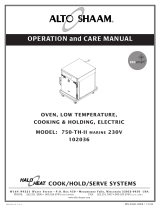 Alto Shaam 750-TH-II MARINE 230V Operating instructions
Alto Shaam 750-TH-II MARINE 230V Operating instructions
-
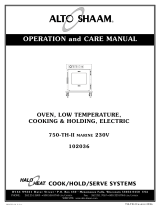 Alto Shaam 750-TH-II MARINE 230V Operating instructions
Alto Shaam 750-TH-II MARINE 230V Operating instructions
-
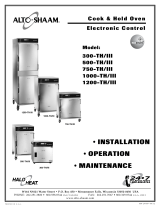 Alto-Shaam 1200-TH/III Specification
Alto-Shaam 1200-TH/III Specification
-
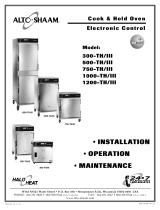 Alto-Shaam 750-TH/III User manual
Alto-Shaam 750-TH/III User manual
-
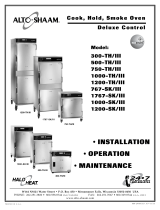 Alto-Shaam 750-TH/III User manual
Alto-Shaam 750-TH/III User manual
-
Alto-Shaam 1000-S Series Installation Operation & Maintenance
-
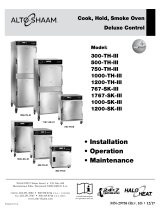 Alto-Shaam 1000-SK/III Installation Operation & Maintenance
Alto-Shaam 1000-SK/III Installation Operation & Maintenance
-
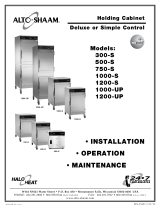 Alto-Shaam 1000-S User manual
Alto-Shaam 1000-S User manual
-
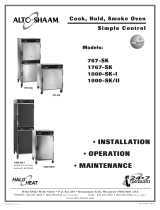 Alto-Shaam 1000-SK/II User manual
Alto-Shaam 1000-SK/II User manual



































